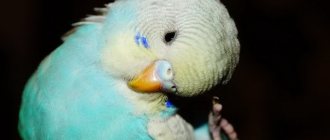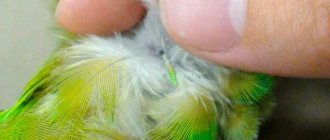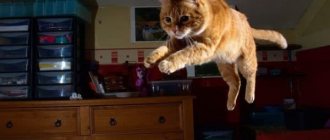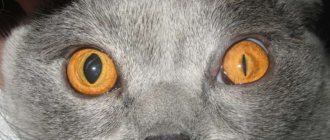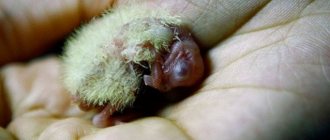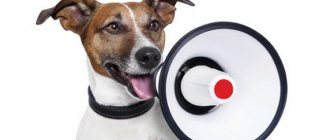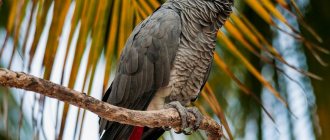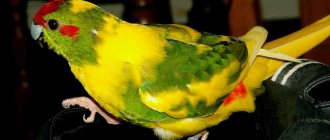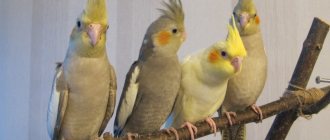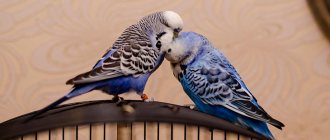There are many reasons why your pet parrot may be plucking feathers. In the following article we will try to consider each of them and give a number of recommendations on how to bring your pet's behavior back to normal.
If your parrot's feathers fall out or he plucks them on his own, then you should immediately pay attention to this. It is possible that you are observing a natural process of changing your pet’s feather cover, but in some cases this may not be the case at all.
Keep in mind that a parrot without feathers is like a person without arms. That is why plumage plays a very important role in the life of every parrot. However, let’s not get too ahead of ourselves and consider each of the possible reasons in more detail.
Shedding
Every self-respecting bird breeder should know what molting is and when it occurs. It is during periods of molting that old feathers of parrots are replaced by new ones.
This process usually occurs a couple of times a year, in spring and autumn. At such moments, your feathered fidget loses feathers evenly. This means that the loss of old feathers occurs as if unnoticed, without leaving noticeable bald spots and areas devoid of feathers on the pet’s body. The fact that the molting process is already underway can be understood by the increased number of feathers falling onto the floor of the cage.
Typically, when your parrots start moulting, they become more irritable due to the itching caused by the growing stubs of their new feathers. In such cases, it often happens that the pet can pull out its own feathers.
However, molting may be accompanied by some complications. In particular, if your pet begins to tear its skin until it bleeds, and new plumage still cannot grow, then this is already a cause for concern.
Reasons for self-plucking
There are many reasons that provoke birds to pluck their own (and their partners’) feathers. This behavior is observed in cases of illness, poor living conditions and mental disorders of the bird. Let's look at each reason in more detail.
Diseases
The most common culprits of self-plucking are parasites that have settled on the skin of birds and fungal diseases.
Scabies mite. Knemidocoptic mange (scabies) is a terrible disease in birds. Parasitic mites settle in the upper layer of the epidermis, where they gnaw tunnels. Malicious creatures use the cell layer and tissue fluid as food.
Knemidocoptic mange does not pose a threat to humans. The scabies mite, when it gets on human skin, dies within 1-2 days.
The activity of parasites provokes severe itching and peeling of the skin in birds. The decay products of mites also poison the bird’s body with toxic toxins. It is difficult to see microscopic creatures on the skin of a bird - the size of the mites is 0.4-0.5 mm.
Symptoms. The disease goes through four stages of development:
- Initial. The insidiousness of the disease is that the symptoms are not detected immediately. At the initial stage, it is impossible to recognize the disease. Knemidocoptic mange appears as soon as the mites reach the adult stage (this takes 3-4 months).
- Easy. On the paws and the area of the beak (cere) growths similar to limestone piles form. The skin flakes, itches, and begins to peel off. A sick parrot gnaws its paws and pulls out feathers, trying to scratch its itchy skin.
- Average. Scabies is already pronounced. The mite occupies almost the entire body of the unfortunate bird. The parrot eats poorly due to a deformed beak and furiously plucks its feathers until it bleeds. The bird's behavior is sluggish and lifeless.
- Heavy. The poor bird is completely deprived of its feather cover. The skin and beak are covered with rough growths. Inflammation of the joints begins (if the parrot loses its limbs, it dies).
Causes of the disease. Where does the terrible creature come from among parrots living at home? The bird becomes infected with mites in the pet store due to a decrease in immunity. The mite enters the cage along with poor-quality, dirty food and as a result of living in unsanitary conditions.
Prevention. The veterinarian will recommend what medications to use. But the owner should make efforts to prevent the parasite from reaching his beloved bird. What are the preventive measures?
- Feed your pet good, clean food (make sure the food is vacuum packed).
- Don't forget to feed your parrot with vitamin supplements.
- Clean and tidy your pet's home regularly.
- Before introducing a new bird, maintain quarantine (30-40 days).
- Before adding new feeders, drinkers, or toys to the cage, disinfect the accessories.
Down-eaters. Or mallophagosis. Lice eaters (they are also called “chicken lice”) are small (1.5-2 mm long) parasitic insects. They live on the skin of parrots and feed on horny scales and feather particles. Budgerigars are more often affected by the disease.
Pooh-eaters are not dangerous to people, but they cause a lot of harm to parrots (parasites are especially dangerous for young individuals and chicks).
Symptoms of the disease. When infected with parasites, the parrot becomes irritable and aggressive. The bird loses its appetite, it furiously scratches its skin and plucks feathers, pecking at the skin surface.
Feathers affected by lice eaters become full of holes, their tips become deformed and curled. The birds' eyes become inflamed and the feathers on their backs completely fall out. Newborn chicks die.
Down-eaters are visible to the naked eye - they look like dark, moving sticks. The lice eaters instantly infect their cage neighbors, and the parrots begin to pluck each other's feathers.
Causes of infection. Infection occurs through contact with a sick individual. Young chicks pick up lice eaters from their sick mother. A new pet (that has not passed quarantine) brings parasites with it. Poison eaters sneak into the cage along with bad food and dirty toys. Much depends on the bird’s immunity – frail, weakened individuals are more likely to become infected.
Prevention. It has been observed that down-eaters cannot tolerate certain odors. If you suspect parasites, place crushed bird cherry and birch leaves in the cage. Use lavender and chamomile to get rid of pests (but place these plants in a fabric bag, they are poisonous to birds).
Ornithologists advise constantly placing wormwood branches near the cages. The pungent smell of the plant repels lice eaters (parasites are especially active in hot summers; the hotter it is, the better the conditions for them). And periodically spray the birds themselves with infusions of these herbs.
Fungal diseases. Fungal infections in parrots are called mycoses (mycotoxicoses). The culprits of the diseases are parasitic fungi that parasitize the digestive organs and mucous membranes.
Depression
Another common reason why parrots pluck feathers is basic depression.
Domesticated parrots are often purchased not only because of their stunning appearance, but also because of their funny behavior and cheerful disposition. These birds can have fun all day long and fly around the room, attracting your attention and responding to your reciprocity.
However, as soon as you stop paying attention to them, they will immediately begin to feel sad. Surely you have seen a picture more than once when a lonely bird retreats into its cage and constantly dozes.
However, other factors can also cause depression. Such as the death of a couple, change of place of residence, chronic lack of sleep, and even food that is unsuitable for the pet. All of this can cause your parrot to start itching and tearing out its feathers.
And if a caring owner immediately pays attention to this, he will certainly correct the current situation. An experienced breeder will not even need to explain what to do and what to do if his pet becomes depressed.
The first thing you need to do is immediately find time to be around your parrot more often. At the same time, it is imperative not only to play with your pet, but also to simply communicate.
Be sure to place some interesting toys near the bird’s house and inside it that the pet could play with in your absence. In addition, you will need to check the poultry feed and, if necessary, replace it with another grain composition.
What can lead to self-plucking?
Very often, in captivity, parrots do not have anyone (bird or human) with whom they can truly communicate, using their natural language, and not a foreign one imposed on them. Also, the mobility of pet parrots is often forcibly limited by periodic trimming of claws and wings. At the same time, some of them completely lose their ability to fly. Many birds are kept exclusively in cages, and their diet leads to various chronic diseases that go untreated for years.
Birds do not have the psychological skills to cope with the restriction of freedom, loss of the ability to fly and social isolation due to lack of communication with their relatives. But for such highly intelligent and socially developed birds as parrots, these issues are much more serious. And their influence is much more catastrophic than for other less intelligent and socially developed birds, such as falcons or owls. This is the main reason why a parrot itches and plucks feathers while living in a cage. And what is much more surprising is that even, regardless of the conditions of detention, some parrots pluck themselves, and some do not.
Indoor air is too dry
Every breeder knows that the homeland of most species of parrots is some country located in the tropical climate zone. All of them are characterized by high air humidity.
When it comes to your apartment, its atmosphere is clearly drier and less comfortable for any type of parrot. As a result, your pet’s skin will likely constantly dry out, peel, and thereby cause irritation. Usually in such cases the parrot is constantly itching.
To somehow alleviate his suffering, you can purchase a special humidifier and spray water on it from time to time. In addition, the bird should be able to bathe whenever it wants.
Dermatitis
At the moments when your tamed pets pluck their feathers and scratch their skin until they bleed, they can catch some disease that significantly complicates an already difficult situation.
Many factors can cause this condition. Such as lack of vitamins, dry air, etc.
If your pet finds itself in such an unpleasant situation, it cannot do without timely help from specialists. So don't delay your trip to the vet. Surely he will immediately advise you to do a series of tests on your domesticated parrot.
Parasite infestation
Another reason why a parrot's feathers fall out could be parasites. Any ornithologist can tell you that there are many different types of parasites that your pet can pick up.
Sometimes a parrot's falling feathers may indicate that something is wrong with it. Take a closer look at each fallen feather. You may be able to detect traces of parasite activity on it.
If this happened, and you found the corresponding signs of the presence of parasites in your pet on the fallen plumage, then it will immediately become clear to you why the parrot plucks its feathers. In this case, treatment will need to begin immediately.
Procedure
As already noted, in order to fix the problem, you need to understand the cause of this condition. If the bird itches or plucks feathers due to nutrition, reconsider the diet of your feathered pet. Give him high-quality grains and special foods that have a balanced composition. Supplement your diet with fresh herbs, vegetables, fruits, and mineral and vitamin supplements.
Systematically monitor the cleanliness of the cells and disinfect them. It is equally important to properly arrange a house for your pet. Place toys in the cage so that the parrot has something to entertain himself with.
If the bird is left alone for a long time, get a second parrot. The birds will have more fun together. Let your pets fly around the apartment. This will help avoid physical inactivity, which also provokes self-plucking.
If a parrot plucks and pulls out its feathers due to mycoses, ectoparasites, or systemic pathologies, consult a veterinarian regarding treatment.
When self-plucking, if the parrot is constantly pulling out feathers, special sprays help well - Beafar spray, Aloe Vera. They have a moisturizing, antibacterial, antiseptic effect, soften the skin, and relieve itching. Before use, carefully read the instructions for the drugs.
If your parrot plucks feathers, use a proven home remedy to apply a solution of baking soda to the bird's feathers at a rate of 1/1. The parrot will not like the bitter taste, and he will stop tearing out his feathers. In case of severe self-plucking, place a protective collar around the bird's neck. This way, parrots simply won’t be able to pluck their feathers.
If the parrot itches a lot, vitamin B12, 1/8, ½ calcium permanganate tablets, eleutherococcus extract will relieve the itching. Lubricate the itchy area with medicinal ointments and creams. To normalize the emotional state, parrots are given an infusion of valerian with honey or sugar.

